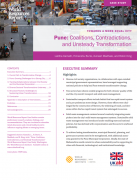Pune: Civil Society Coalitions, Policy Contradictions, and Unsteady Transformation
by , , e -This case study in the World Resources Report, “Towards a More Equal City,” examines the processes of transformative change and the conditions both enabling and inhibiting it in Pune, the second largest city in Maharashtra state, India. Many initiatives across diverse sectors have had a positive, qualitative impact on sustainability and service provision in Pune, particularly in its solid waste and transport sectors between the 1990s and the present. These initiatives reflect important shifts in the local government’s attitudes and systems towards greater sustainability and equity and have had a positive impact on many lives.
Pune’s transformation towards sustainable transportation began in the early 2000s. It has included efforts to reduce dependence on private vehicles by improving public transport through the implementation of India’s first bus rapid transit system and creating more inclusive street space by emphasizing non-motorized transport generally. Improvements in Pune’s solid waste management systems have explicitly linked environmental, labor-related and economic aspects of life in the city by including waste pickers in the formal waste management system of the city. This innovation has also led to new national-level policies. Civil society organizations played a key role in both sectors, aligning with the municipality to catalyze positive reforms for labor, the economy, and the environment.
Case studies in the World Resources Report, “Towards a More Equal City,” examine transformative urban change defined as that which affects multiple sectors and institutional practices, continues across more than one political administration, and is sustained for more than 10 years, resulting in more equitable access to core services. The goal of “Towards a More Equal City” is to inform urban change agents – government officials, policymakers, civil society organizations, citizens, and the private sector – about how transformative change happens, the various forms it takes, and how they can support transformation towards more equal cities.


